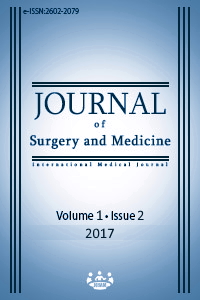Retrospective evaluation of patients presenting with acute abdominal pain in the green area of emergency clinic: A cohort study.
Keywords:
Emergency services, Green area, Acute abdominal painAbstract
Aim: In emergency services applications, patients are stable as a general condition and have simple health problems that may be provided outpatient treatment, are defined as green area patients. Abdominal pain is a common cause of referral to the emergency clinic. In our study, patients admitted to our hospital with acute abdominal pain in the emergency room green areas were evaluated in all respects.
Methods: A retrospective observational study was designed to evaluate patients presenting with acute abdominal pain in green areas. The sample group consisted of 342 patients. Diagnosed / pre-diagnosed patients were identified as specific diagnosis. Diagnosis unclear patients were identified as non-specific diagnosis. Results are evaluated in two categories: 1. Inpatient treatment (surgical or medical treatment), 2. Outpatient (medical treatment ).
Results: The values of hematologic parameters such as BASO%, HCT, PDW, RBC and RDW were statistically significant different between the groups of specific and nonspecific diagnosis. (p in order 0.049, 0.003, 0.015, <0.001 and 0.005). Also a statistically significant difference was found in LY%, MO#, NEU#, NEU%, WBC values between discharged from inpatient and outpatient clinic control groups (p <0.0001, 0.0002, <0.0001, <0.0001 and <0.0001, respectively).
Conclusion: Although non-specific acute abdominal pain is the most common cause of referral to the emergency services green area, careful history, physical examinations and inspections for detection of acute abdominal pain in our patients are guiding us.
Downloads
References
Erdine S. Ağrı 2. baskı. İstanbul: Nobel tıp kitapevleri; 2002. s. 20-9.
Gallagher E. John. Acute abdominal pain. Tintinalli JE. Kelen GD. Stapczynski JS.Emergency Medicine A comprehensive study guide. McGraw-Hill basımevi. 5. Baskı 2000; 497.
Graff LG, Robinson D. Abdominal pain and emergency department evaluation. Emerg Med Clin North Am 2001;19:123-36.
Acil Sağlık Hizmetlerinde Yeşil Alan Uygulaması, http://www.saglik.gov.tr/TR/dosya/1-74852/h/acil-saglik-hizmetlerinde-yesil-alan-uygulamasi.pdf, son erişim tarihi: 26.02.2016).
Lameris W, Randen A, Dijkdraaf M, Bossuyt P, Stoker J, Boermeester M. Optimization of diagnostic imaging use in patients with acute abdominal pain (OPTIMA): Design and raionale. BMC Emergency Medicine 2007;7:9.
Stefanidis D, Richardson WS, Chang L, Earle B, Fanelli RD. The role of diagnostic laparoscopy for acute abdominal conditions: an evidence-based review. Surg Endosc. 2009;23:16-23.
Bavunoğlu I, Şirin F. Akut cerrahi karını taklit eden cerrahi dışı nedenler. Türkiye Klinikleri Cerrahi Tıp Bilimleri 2005;10:30-35.
Özgüç H, Çakın N, Duman U. Akut nonspesifik karın ağrılı olguların bir yıllık prognozları, semptom ve bulguların tanısal doğruluğu. Ulus Travma Acil Cerrahi Derg 2008;14:118-24.
Pehlivan T, Çevik AA, Ateş E. Akut kolesistitli hastalarda demografik, klinik ve laboratuvar bulgularının ultrasonografik bulgularla ilişkisi. Ulus Travma Acil Cerrahi Derg 2005;11:134-141.
Dursun M, Yılmaz Ş, Canoruç F, Batum S, Kaplan A. Akut pankreatitli olgularımızın analizi. Dicle Tıp Dergisi 2001;28:19-27.
Kaya D, Atadağ Y, Köşker HD, Aydın A, Aydoğdu S. Distribution of microorganisms and antibiotic resistance in children with urinary tract infections: Retrospective case series. J Surg Med 2017;1:9-11.
Cueto J, Diaz O, Garteiz D, Rodrigez M, Weber A. The efficacy of laparoscopic surgery in the diagnosis and treatment of peritonitis. Experience with 107 cases in Mexico City. Surg Endosc 1997;11:366-70.
Eryılmaz R, Şahin M, Alimoğlu O, Baş G, Özkan OV. Negatif apendektomileri önlemede C-Reaktif protein ve lökosit sayımının değeri. Ulus travma Acil Cerrahi Derg 2001; 17:142-45.
Jaffe BM, Berger DH. Appendiks.In:Brunicardi FC. Schwartz's Principles of Surgery. 8th edition.New York: Mc Graw-hill, 2004: p. 1119-39 .
Yang HR, Wang YC, Chung PK, Chen WK, Jen LB, Chen RJ. Laboratory tests in patients with acute appendicitis. ANZ J Surg 2006;95:631-7.
Raheja SK, McDonald PJ, Taylor I. Non-specific abdominal pain-an expensive mystery. J R Soc Med 1990;83:10-1
Andersson RE. Meta-analysis of the clinical and laboratory diagnosis of appendicitis. Br J Surg. 2004;91(1):28-37.
Kamran H, Naveed D, Nazir A, Hameed M, Ahmed M, Khan U. Role of total leukocyte count in diagnosis of acute appendicitis. J Ayub Med Coll Abbottabad. 2008;20(3):70-1
Goodman DA, Goodman CB, Monk JS. Use of the neutrophil:lymphocyte ratio in the diagnosis of appendicitis. Am Surg. 1995;61(3):257-9.
Yazici M, Ozkisacik S, Oztan MO, Gürsoy H. Neutrophil/lymphocyte ratio in the diagnosis of childhood appendicitis. Turk J Pediatr. 2010;52(4):400-3.
Markar SR, Karthikesalingam A, Falzon A, Kan Y. The diagnostic value of neutrophil: lymphocyte ratio in adults with suspected acute appendicitis. Acta Chir Belg. 2010;110(5):543-7.
Goulart RN, Silvério G de S, Moreira MB, Franzon O. Main findings in laboratory tests diagnosis of acute appendicitis: a prospective evaluation. Arq Bras Cir Dig. 2012;25(2):88-90.
Downloads
- 3126 1671
Published
Issue
Section
How to Cite
License
Copyright (c) 2017 Umut Kayışoğulları, Fatih Başak, Sema Uçak
This work is licensed under a Creative Commons Attribution-NonCommercial-NoDerivatives 4.0 International License.















